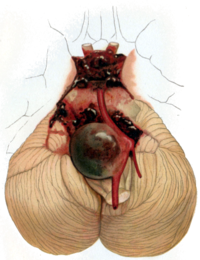
Photo from wikipedia
BACKGROUND Flow diverter (FD) treatment of ruptured fusiform posterior cerebral artery (PCA), posterior inferior cerebellar artery (PICA), and superior cerebellar artery (SCA) aneurysms are limited to single reports. OBJECTIVE To… Click to show full abstract
BACKGROUND Flow diverter (FD) treatment of ruptured fusiform posterior cerebral artery (PCA), posterior inferior cerebellar artery (PICA), and superior cerebellar artery (SCA) aneurysms are limited to single reports. OBJECTIVE To study the safety and efficacy of FD treatment for ruptured fusiform aneurysms of the PCA, SCA, and PICA. METHODS Five patients with ruptured posterior circulation fusiform aneurysms and treated with a Flow-Redirection Endoluminal Device (FRED/FRED Jr; Microvention, Tustin, California) stent in the acute phase of subarachnoid hemorrhage between 2013 and 2016 were included and reviewed retrospectively. RESULTS Two aneurysms located on the PICA, 2 on PCA, and 1 on the SCA. Mean treatment time with FD was 5.8 d (range, 0-11 d) from ictus. The technical success rate was 100%. On admission 2 patients were Hunt and Hess grade 1, 2 patients grade 3, and 1 patient grade 4. At discharge, 4 patients (80%) were independent (modified Ranking Scale (mRS) ≤2) and 1 patient had severe disability (mRS 4). None of the patients had aneurysmal rebleeding. All 5 aneurysms were completely occluded on angiographic follow-up (range, 3-22 mo). One patient had permanent intraprocedural in stent thrombosis and brain infarction. One patient had spontaneous nonaneurysmal intracerebral hemorrhage 1 mo after FD treatment. External ventricular drainage was inserted in 3 patients and ventriculoperitoneal shunt in 2 patients without hemorrhagic complications despite dual antiplatelet therapy. CONCLUSION FD could be considered as a treatment option for ruptured fusiform aneurysms located on PCA, PICA, or SCA when other treatment options are challenging.
Journal Title: Operative neurosurgery
Year Published: 2019
Link to full text (if available)
Share on Social Media: Sign Up to like & get
recommendations!